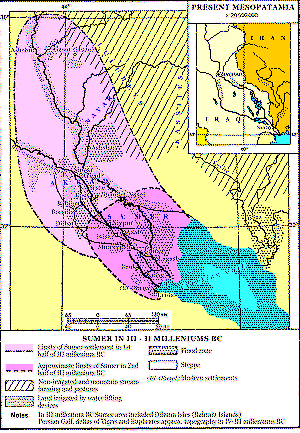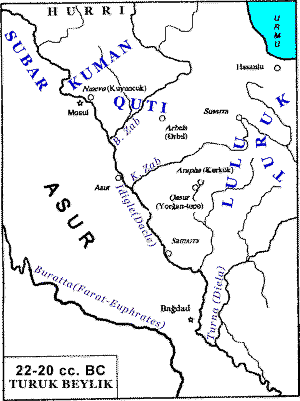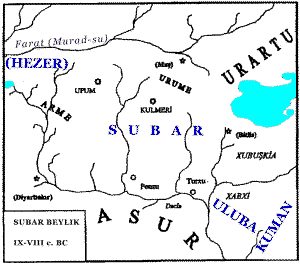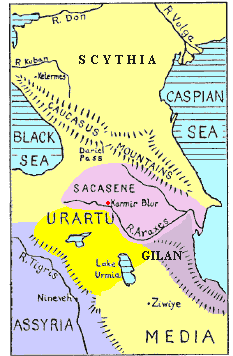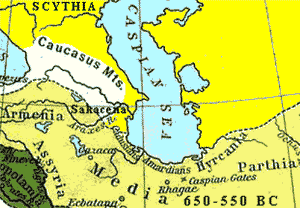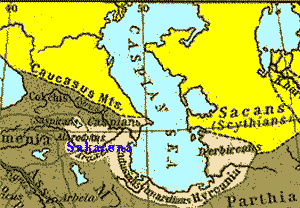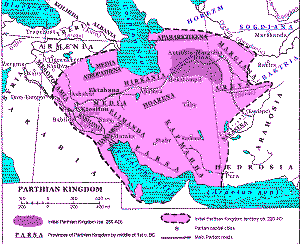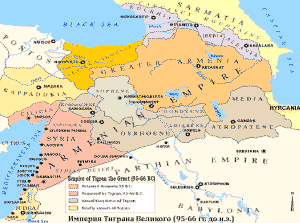Links
Posting Foreword
The Türkic history in the Caucasus did not start with Cimmerians and Scythians at about 9th c. BC, it started with the horse husbandry tribes north and east of the sedentary agricultural states in Mesopotamia and along the southern coast of the Caspian Sea in the 3rd millennium BC. The Sumerian and Assyrian records list the names of those tribes at about 20th-23rd cc. BC: Kuman, Lulu, Quti, Turuk, and Subar. 15 centuries later, Kuman, Lulu/Uluba, and Subar are still there. In the 9th c. BC to their number joined Cimmerians and Scythians. Another 5 centuries later, we get a peek at the Caspian shores more to the northeast, from west to east are recorded Gelon, Yiyrk and Dahae. That was the end of the early historical period when the information was too spotty for a sustained picture, and a beginning of more informative descriptions. The initial scene is decorated with animal husbandry nomadic tribes with similar economies, the origin of which is fairly well known only for the Scythians: they brought their Kurgan culture from the Altai highlands. The Dahae and Yiyrk tribes are likely one and the same, since Yiyrk is nothing more than a generic “nomad” in Türkic, their later names were Tokhars, Yuezhi, Dügers, Digors, and Tuhsi, their western territory was called Hyrcania, in the 200 BC they were expelled from the Ordos-Tarim basin, from the Jeti-su they were expelled in 176 BC, they regrouped in their ancestor center between Aral and Caspian seas, and went on to capture Bactria at about 140 BC, along with the Ash-guzai Scythians known as Ases and Subars known as Subaroi. Another part of the Dahae Tokhars took over control of the Seleucid state (future Persia), which for the next 22 centuries inherited their name Parthia, a derivative of their tribal name Pardy (labialized Bardy). A branch of the Ash-guzai Scythians in 620 BC established a state Sacasene within the future Greater Armenia, they probably belonged to the same stem as the Ases in the As-Tokhar confederation. Since the endonym of the Ash-guzai Scythians was As-eri, they immortalized their name as the people of Azeri. The fate of Sacasene Azeris was inseparable form the fate of Armenia, soon it fell under Achaemenid control (550–330 BC), then Seleucid control (330–247 BC) , then under Parthian control (247 BC – 224 AD), and finally, déjà vu with their kins Gilans and Sarmats, the last were brought over by Iberians in 35 BC for Ibero-Parthian war, possibly first as mercenaries (Tacitus, Annals 6.33: N.Pontic Sarmats; J.Flavius, 94 AD, Antiquities of the Jews 18.97: N.Pontic Scythians). The timing of Gilan's arrival to Hyrcania is not known, in the Herodotus time they were in the N.Pontic, but that does not exclude their prior or simultaneous presence in the Hyrcania area. By 150 AD to the SW corner of the Caspian Sea migrate Huns, later instead of the generic Huns is named the Hunnic “old” maternal tribe of Kayı, the Hailandurs of Armenian chroniclers. That coincides with the first mentioning of Caucasian Aghuania, the Aghbania of the Armenian chroniclers and Albania of the Greek and Latin authors. The last antique players to the scene come the Savirs, who in the 5th. c. arrive from the north, and in 7th c. take over control over the Aghuanians, Masguts, and Kayı Huns, but leave the Azeris of Sacasene, and Gilans of Hyrcania to the expanding Arabs. In the north of the Caucasus range we know Bulgars, Masguts under a name Alans, and Bulgar kins Khazars. In the following description, the descendents and composites of all these Türkic nomadic pastoralists are compiled under the Caspian anthropological type, as a “least correlated type”. No wonder, these tribes brought along all the admixtures collected during their individual histories; what is common to them all is the predominant blood group B (III in the Russian nomenclature), and the negative rhesus factor (omitted in the citation): B-.
Cranial Index has three main grades: brachy-, meso-, and dolichocephaly. Brachycephaly - (Greek brachys - short and Greek kephale - head) (short head) - is the ratio of maximum length to maximum width of the skull with width equal or more than 0.81 (cephalic or cranial index) of the lengths; mesocephaly - (Greek mesos - medium) is a grade with cranial index 75.0-79.9% that defines a moderately long and wide skull; dolichocephaly - (Greek dolichos - long) is a grade with cranial index 75.9% and below.
200-300 years ago, the Ossetians did not exist neither as a genetic unity, nor as a political entity. However, the Russian scholars know measurements of the then non-existing population, probably Nakhs, Chechens i Russian parlance. According to that funny systematization, the cephalic index of Ossetians has increased over the past 200-300 years by five or six units, an increase in cerebral index is accompanied by an increase in the width of the face ["Peoples of the Caucasus”,editor E.Krupnova, M., 1960. V.1].In science, encountering unexpected phenomena leads to new discoveries, but the Soviet anthropology not only takes biological wonders for granted, but keeps inventing them.
The Caspian type supposedly formed in the process of settlement in the Caucasus from the south-east, and the Caucasian and Pontic types were influenced by the northern peoples, who were spreading in southerly direction to the central regions of the Caucasus mountain range and to the Asia Minor in the west. The migration of the Russians was accompanied by spread of light-eyed and fair-haired Nordic type (“Peoples of the Caucasus”).
Modern Balkars, Karachais and Ossetians belong to the Caucasian anthropological type. The complex of morphological features inherent in this type exists in the mountains of the Central Caucasus for at least 3,000 years, that is, it ascends to the time of the Koban culture. Biologically, the Koban culture is a mix of the Ases ~ Ash-guzai Scythians with the local tribes. The anthropological description of the Koban people is: “Tall, slender, with long arms and legs, a prominent nose, just take a look at our Karachai-native shepherd” [V.B. Kovalevskaya, Caucasus and Alans, pp. 170-171}. The irony of such august claims lies in the fact that traditionally the dominant ethnic group is called Ak = White, and dependent ethnic group is called Kara = Black, and together they are called with the name of the dominant ethnic group: Ases = Ak Ases + Kara Ases, respectively the ethnonym of Karachais - Hara-As - Kara As = Black Aces indicates that they are of local, non-Scythian origin.
CASPIAN TYPE
Formed from the Pamir-Fergana (low-statue brachycephals), Indo-Iranian and Balkan-Caucasus branch
(Near Eastern type) of Caucasian race. Described by Bunak in 1947. It is a least correlated type.
Stable traits are: height, eye color, hair color, skull structure. The
nasal back is usually straight, but with mestization with Armenoid (Assyrians, Armenians,
Jews) appears a convex shape.
Most typical for the Caspian type people is group of
blood III (B)
Type is divided into Western and eastern (Turkmen) clusters.
Essentially, Caspian type describes Türkic people around Caspian Sea area and their
extensions to the west (Balkan-Caucasus branch) and south (Arabs, Iraqi (eastern part),
Kuwaiti Arabs, apparently Türkic Persians, Western Iranians). In reverse chronological order, the
Türkic people around Caspian Sea included
Turkish peoples (a compendium of genetically autonomous tribes with prevailing Turkmen
component)
Kumyk (a compendium of genetically autonomous tribes, the Hunnic Kayi, Gilan,
Masgut/Alan, Balkar As, Tokhar Digor, Savir, Bulgar and Khazar, with no detectable
prevalence of any component)
Savir (Svan, Swan, or Svanet in Georgia)
Masgut/Alan (Meskhi tribe ~ Meskhetian Türks, scattered after consecutive deportations)
Azeri (Azerbajan and Persia or Iran; Ingiloy in Georgia)
The Caspian type supposedly formed in the process of settlement in the Caucasus from the south-east, and the Caucasian and Pontic types were influenced by the northern peoples, who were spreading in southerly direction to the central regions of the Caucasus mountain range and to the Asia Minor in the west. “Peoples of the Caucasus” The migration of the Russians was accompanied by spread of light-eyed and fair-haired Nordic type (“Peoples of the Caucasus”).
“Peoples of the Caucasus” modestly adds that “the Russian migration was accompanied by propagation of light eyes and blond Scandinavian (Nordic) type” (“Peoples of the Caucasus”), a highly politicized statement that instantly transforms genetically Finnish and Turkic Russians to the blond-Aryans like the blond-Brahmins, a la the mongrel scheme of Hitler.
| Type | CASPIAN |
|---|---|
| Subtype | Western, Southwest, Eastern (Turkmen) |
| Population | Azeri, Kumyk, Persian, Arabs, Iraqi (eastern part), Kuwaiti Arabs, Tat-Muslim, Ingiloy (Georgian Azeri), and other Western Iranian peoples (except Kurd, Lur and Bakhtiari) |
| Blood group predominance | III (B) |
| Height | low-and medium (<164-166 cm) |
| Statue | heavy-boned |
| Hair | black and dark brown (93%) |
| Eyes | black (80%), some dull green, Near Eastern type |
| Eye slit | medium, horizontal, 30% “Mongoloid” shape, between eyes distance large, arched eyebrows |
| Body hair | medium |
| Face | round, medium and narrow, high, cheeks non-protruding |
| Crania, cranial index | mesocephaly and sub-brachycephaly (77-80) |
| Nose | short, broad, protruding, straight back, tip horizontal or raised |
| Nose bridge | |
| Nose profile | |
| Lips | thick |
| Chin | low, non-protruding, broad lower jaw, space between nose and upper lip large |
| Occiput | convex |
| Ears | long lobes |
CAUCASIAN TYPE equated with Dinaric type
Type formed in the 3rd mill. BC in Caucasus Mountains highlands from proto-Near Eastern type. It is found only in the Caucasus. It was described by Natishvili and Abdushelishvili in 1954. Some scientists believe that Caucasian type was formed from ancient Cro-Magnon people of Caucasus mountains and migrant Hurrians-Urartians Near Eastern type. In many respects Caucasian type is similar with Pontic type. Parallel forms are ultra-Dinaric type (Balkan Borrebis) of Karatag (Montenegro), Albania, and Crete with lower skull and darker color. The Russian anthropology (Alekseev, Alekseeva) equated Caucasian type with Dinaric type, which is fundamentally not true. Are discerned Central, Southern, and Dagestani clusters.
Very high percent of blood group II (A), particularly A2 (5% of carriers of group II (A)). Such high percent high of A2 have Caucasian and Lapponoid types.
The case with Ossetians is tricky, probably no more tricky than any other ethnic group, but for Ossetians we have detailed information not available for many other groups. The Russian conquest early in the 19th c. captured the N.Caucasus lands with numerous ethnic names (Digoria, the present North Ossetia was captured in 1767), including the people Digors (politically in Northern Ossetia), Irons (politically in Southern Ossetia), and Taulases (Tawlases/Tavlases, self-name Tualläg, Türkic Tawlu ”mountaineer”, politically in Southern Ossetia), whom the Russian military administration, with all the military decisiveness and intellectuality, at first termed Tatars. During the Russian conquest, a Russian military report of 1834 called Karachais and Balkars the ”Ossetian tribes”. Then the territory was subdivided into military districts and one of them was termed Osset. Not the Karachais and Balkars with their self-name Ases, but their neighboring tribes. Now each Ossette has 2 or even 3 ethnonyms, with the latest addition of the Northern and Southern Ossetias. Meanwhile, the Iron, Digor, and Taulas Ossetes continued to call their Türkic Balkar neighbors Ases. Thus, neither Irons, nor Digors, nor Taulases call themselves Ases, it is their name for the neighboring peoples. The Balkars hold themselves to be Ases, their substrate self-appellation is Alan, they do not use the term Ases for Ossetes, or Irons, or Digors, or Taulases. In Türkic, the Tauly Ases are Mountain Ases, they were the closest neighbors to the Georgians, and gave their name to the Georgian term “Ovs”. Ases were a dynastic tribe of the As-Tokhar confederation, and As was an ethnonym of the ruling tribe and politonym for all other members of the confederation. But after the Russian military blunder of naming Ossetes after the once-dominant Balkars-Ases, now the Ossetes became Ases themselves, and claim the legacy of Alans. The absurdity made a full half-circle, without the Türkic Balkars-Ases, the Ossetes would not have their assumed appellation. The historical background allows to suspect the falsity of “Osset” phenotype: how three different ethnic groups, with three distinct origins and three distinct admixtures, can fit into a single phenotype?
| S. Ossetia Ironians | N. Ossetia Digorians | N. Ossetia Ardonians | Balkars |
|---|---|---|---|
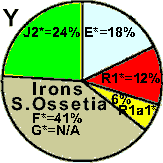 |
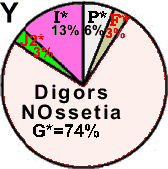 |
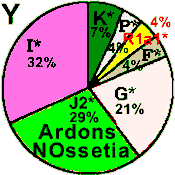 |
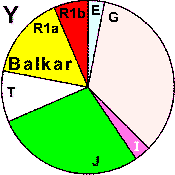 |
Correspondingly, the non-discriminated measurements for “Ossetes” are suspicious and non-compatible across time line and ethnic lines. For the cephalic index of Ossetians, published data reports that it has increased over the past 200-300 years by five or six units, with the increase in cerebral index accompanied by an increase in the width of the face ["Peoples of the Caucasus”,editor E.Krupnova, M., 1960. V.1]. Which of the Ossetes, Iron, Digor, or Taulas has increased? For Irons we know that genetically they are Nakhs, with the admixture of some female Persian breed; for Digors we know that they are a splinter of Dügers living across the Caspian Sea, the Düger Turkmen group; which one had their cephalic index increased by five or six units? The genetically-Nakh Irons had room to increase their skulls from dolichocephalic toward brachycephaly, but the Digors, like their brethren Balkar Ases, were brachycephalic to begin with, so the measurements and reports are driven solely by political transformations. Unless the selection of the etalon is sane, the comparison cant be ensured to be sane.
In the politically-muddled anthropology, the modern Balkars, Karachais and Ossetians belong to the Caucasian anthropological type. The complex of morphological features inherent in this type exists in the mountains of the Central Caucasus for at least 3,000 years, that is, it ascends to the time of the Koban culture. Biologically, the Koban culture is a mix of the Ases ~ Ash-guzai Scythians with the local tribes. The anthropological description of the Koban people is: “Tall, slender, with long arms and legs, a prominent nose, just take a look at our native Karachai shepherd” [V.B. Kovalevskaya, Caucasus and Alans, pp. 170-171]. A similar picture pertains to the Svans, the former Savirs, the former Subars, who have their own distinct history, admixtures, and phenotype.
| Type | CAUCASIAN TYPE | ||
|---|---|---|---|
| Subtype | Central | Southern | Dagestani |
| Population | Karachai, Balkar, Ossetians, Ingush, Chechen, Batsbiy, Avar-Ando-Tsez, part of Mountain Jews (Tats) | Svan, Khevsur, Mohe, Tush, Pshavi, Mtiul, Gudamakar, Rachi, South Osset (Iron) | Lezgin, Dargin, Lak, Hinalug, part of Karabakh |
| Blood group predominance | II (A) (high A2) | ||
| Height | high > 170 cm | average | medium and low |
| Statue | medium bones, long torso | => | => |
| Hair | coarse, straight, black (often reddish-chestnut and hazel) | => | black ( almost never blonde) |
| Eyes | brown and gray | => | black |
| Eye slit | narrow, horizontal, straight eyebrows | => | => |
| Body hair | developed | => | weak |
| Face | low, broad (14,6-14,8 cm), angular, wide subtle cheeks, low forehead | => | => |
| Crania, cranial index | brachycephaly (84-85) | => | mesocephaly (78-79) |
| Nose | long, wide, flaring to the tip | long and wide | long, wide, flaring to the tip |
| Nose bridge | narrow | => | => |
| Nose profile | straight, rarely convex, tip horizontal or bent down | upper third hump, tip horizontal | straight, rarely convex, tip horizontal or bent down |
| Lips | thick | => | => |
| Chin | low, sharp, protruding, narrow jaw | => | => |
| Occiput | convex | => | => |
| Ears | high, long lobes | => | => |
PONTIC TYPE
Type developed in Asia Minor and the north-western Caucasus in 4th-3rd mill. BC by mixing Near Eastern brachycephalic and Mediterranean dolichocephalic tribes. Described in 1932 by Bunak. There are Northwestern, Southwestern, Pyatigor, Colchis, Lower Danube, Byzantine types. South-Western Pontic type is similar to the Caspian branch of Indo-Iranian type.
Very high percent of blood group II (A), particularly A2 (5% of carriers of group II (A)). Such high percent high of A2 have Caucasian and Lapponoid types.
| Type | PONTIC TYPE | |||
|---|---|---|---|---|
| Subtype | Northwestern/Kuban (“basic”) | Southwestern | Pyatigor | Colchis |
| Population | Adygs (Circassians) - except Western Circassians | Western Adygs (Circassians) - Shapsug and Bjedug | Kabarda, part of Ingush and Osset | Abkhaz, Abaza, Megrels, Lechhum, Laz, Guri, Imeret, Imerh |
| Blood group predominance | II (A), particularly 5% A2. Such high percent high of A2 have Caucasian and Lapponoid types | |||
| Height | high (> 170 cm) | medium (164-165 cm) | => | Laz (166-167 cm), others (164-165 cm) |
| Statue | medium bones, long torso | => | => | => |
| Hair | coarse, straight, black, often hazel | usually black | => | => |
| Eyes | black (50%), brown and gray (50%) | black, almost no light shades | => | some blonde hair and gray eyes, mostly at Abkhaz and Abaza |
| Eye slit | narrow, horizontal or “Near Eastern”,straight eyebrows, often fused | => | => | => |
| Body hair | medium, mustache and beard sparse | => | => | developed |
| Face | narrow, long, angular, cheeks seen in profile, high forehead | broad | => | => |
| Crania, cranial index | mesocephaly (80-81), often sub-brachycephaly | => | => | => |
| Nose | long, narrow, straight, non-protruding; tip horizontal, sometimes raised; | => | sometimes hooked; tip horizontal | broad flat back (sometimes concave) |
| Nose bridge | => | => | => | |
| Nose profile | often nose and forehead form single line | => | => | => |
| Lips | thick | => | => | => |
| Chin | high, non-protruding | => | => | => |
| Occiput | convex | => | => | flat |
| Ears | high with long lobes | => | => | => |
NEAR EASTERN TYPE
Initially this type was ancient Nostratic (of “Macrofamilies”), living from Palestine (pra-Kartvel Rephaim) to Mesopotamia and Zagros ridge in Iran (ancient Semites) and Alarodians (Sino-Caucasians). That type formed the core of the Indo-Iranian branch (mestization with Australoid Veddoid race in Iran and India), and includs the Semito-Aravian admixture (mestization of Armenoids with Dravidians and Mediterraneans of Arabia). Described in 1911 by von Lushan. In many respects Near Easterners are close to Caucasoids and Dinarians (Balkans), but differ by small stature, shape of nose and flatness of the occiput. Other terms for this type are: Armenoid, Alarodian (Urartu), Syrian-Zagros, Semitic, Pontic-Zagros, Hettic, Assyroid, and Taurian. Deniker calls this type Assyroid and believed that it is characterized by straight, narrow nose. The incidence of straight nasal line has no geographic association, it is a result of frequent mestization Armenians and Jews with other peoples (mostly, if other people professed Judaism or Gregorianism, because frequently mono-ethnic religious confession was identified with ethnicity). There are albino, usually within the phenotype of the central cluster - Near Eastern features, plus blonde hair and eyes. Some of the alternative names for Near Eastern type are used to denote related types, for example the Assyroid type, common among the Kurds and Assyrians, is less brachycephalic and the nose is straight and narrow. The Semito-Aravian (aklso euphemized as Afro-Aravian) type is often called Semitic type.
For the peoples of Near Eastern type is typical blood group II (A).
The “Sino-Caucasian” species makes as much sense as a “Feline Dog” species, in both cases their genetics is totally different and kinship is excluded. “Sino-Caucasian” category is a somewhat accepted strictly linguistic hypothesis-isolate, concocted in insularity of any discipline outside of some particular linguistic models, to explain Sino-Caucasian linguistical correspondences that with Occam Razor would be explained by regular cultural borrowings, in conformance with other disciplines, from the people who populated both Northern China and Caucasus: the Türkic nomadic tribes, Zhou and Juns in China, and As-guzai Scythians in the Caucasus.
| Type | NEAR EASTERN | |
|---|---|---|
| Subtype | Central Near Eastern Cluster | Ibero-Caucasian cluster |
| Population | Armenians, Turks (center and eastern), Meskhet Turks, Jews of Israel, Syrian-Palestine Arabs (Palestine, Syria, Lebanon, Jordan), some Western-Iranian nations (Lurs, Bakhtiaris, Talysh, Muslim Kurds), Djavahi, Meskhi |
Kakhetians, Kartli, Fereydan (Ingiloy/Georgians |
| Blood group predominance | II (A) | |
| Height | small | medium |
| Statue | heavy-boned | => |
| Hair | black, coarse, curly | black, hazel |
| Eyes | mostly black, with some exotic hues (dark blue, dull-green, black with turquoise) | brown and gray |
| Eye slit | wide, typology “Near Eastern": outer corner of eye is below inner corner | horizontal |
| Body hair | well-developed, extending on forehead, joined eyebrows, haired back | |
| Face | oval, broad (up to 143 mm), not high, cheeks non-protruding, eyebrows arched | wide |
| Crania, cranial index | Brachycephaly (86-88) | => |
| Nose | long, broad, convex, hump in the middle third, tip is bent downwards, visible nasal septum | long, straight, broad |
| Nose bridge | => | |
| Nose profile | => | |
| Lips | thick, upper lip protrudes above lower lip | => |
| Chin | small, non-protruding, broad jaw | => |
| Occiput | flat, distinctive trait of Near Eastern type | => |
| Ears | small, often without lobes | => |
